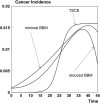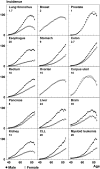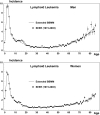New stochastic carcinogenesis model with covariates: an approach involving intracellular barrier mechanisms
- PMID: 22200574
- PMCID: PMC3806491
- DOI: 10.1016/j.mbs.2011.12.002
New stochastic carcinogenesis model with covariates: an approach involving intracellular barrier mechanisms
Abstract
In this paper we present a new multiple-pathway stochastic model of carcinogenesis with potential of predicting individual incidence risks on the basis of biomedical measurements. The model incorporates the concept of intracellular barrier mechanisms in which cell malignization occurs due to an inefficient operation of barrier cell mechanisms, such as antioxidant defense, repair systems, and apoptosis. Mathematical formalism combines methodological innovations of mechanistic carcinogenesis models and stochastic process models widely used in studying biodemography of aging and longevity. An advantage of the modeling approach is in the natural combining of two types of measures expressed in terms of model parameters: age-specific hazard rate and means of barrier states. Results of simulation studies allow us to conclude that the model parameters can be estimated in joint analyses of epidemiological data and newly collected data on individual biomolecular measurements of barrier states. Respective experimental designs for such measurements are suggested and discussed. An analytical solution is obtained for the simplest design when only age-specific incidence rates are observed. Detailed comparison with TSCE model reveals advantages of the approach such as the possibility to describe decline in risk at advanced ages, possibilities to describe heterogeneous system of intermediate cells, and perspectives for individual prognoses of cancer risks. Application of the results to fit the SEER data on cancer risks demonstrates a strong predictive power of the model. Further generalizations of the model, opportunities to measure barrier systems, biomedical and mathematical aspects of the new model are discussed.
Copyright © 2012. Published by Elsevier Inc.
Figures





Similar articles
-
Stochastic simulation of a multistage model of carcinogenesis.Math Biosci. 1996 May;134(1):35-50. doi: 10.1016/0025-5564(95)00105-0. Math Biosci. 1996. PMID: 8935954
-
Stochastic modeling indicates that aging and somatic evolution in the hematopoetic system are driven by non-cell-autonomous processes.Aging (Albany NY). 2014 Dec;6(12):1033-48. doi: 10.18632/aging.100707. Aging (Albany NY). 2014. PMID: 25564763 Free PMC article.
-
On the exact hazard and survival functions of the MVK stochastic carcinogenesis model.Risk Anal. 1994 Dec;14(6):1081-4. doi: 10.1111/j.1539-6924.1994.tb00079.x. Risk Anal. 1994. PMID: 7846316
-
Space as the final frontier in stochastic simulations of biological systems.FEBS Lett. 2005 Mar 21;579(8):1789-94. doi: 10.1016/j.febslet.2005.02.009. FEBS Lett. 2005. PMID: 15763553 Review.
-
Systems biological and mechanistic modelling of radiation-induced cancer.Radiat Environ Biophys. 2008 Feb;47(1):39-47. doi: 10.1007/s00411-007-0150-z. Epub 2007 Dec 21. Radiat Environ Biophys. 2008. PMID: 18097677 Free PMC article. Review.
Cited by
-
Evaluating the number of stages in development of squamous cell and adenocarcinomas across cancer sites using human population-based cancer modeling.PLoS One. 2012;7(5):e37430. doi: 10.1371/journal.pone.0037430. Epub 2012 May 22. PLoS One. 2012. PMID: 22629394 Free PMC article.
-
Genetics of aging, health, and survival: dynamic regulation of human longevity related traits.Front Genet. 2015 Apr 13;6:122. doi: 10.3389/fgene.2015.00122. eCollection 2015. Front Genet. 2015. PMID: 25918517 Free PMC article.
-
How Genes Modulate Patterns of Aging-Related Changes on the Way to 100: Biodemographic Models and Methods in Genetic Analyses of Longitudinal Data.N Am Actuar J. 2016;20(3):201-232. doi: 10.1080/10920277.2016.1178588. Epub 2016 Jun 22. N Am Actuar J. 2016. PMID: 27773987 Free PMC article.
-
Chemical compounds from anthropogenic environment and immune evasion mechanisms: potential interactions.Carcinogenesis. 2015 Jun;36 Suppl 1(Suppl 1):S111-27. doi: 10.1093/carcin/bgv033. Epub 2015 May 22. Carcinogenesis. 2015. PMID: 26002081 Free PMC article. Review.
References
-
- Moolgavkar S, Krewski D, Schwarz M. Mechanisms of carcinogenesis and biologically based models for estimation and prediction of risk. In: Moolgavkar S, Krewski D, Zeise L, Cardis E, Møller H, editors. In Quantitative Estimation and Prediction of Human Cancer Risks. Scientific publications No. 131, International Agency for Research on Cancer; Lyon: 1999. pp. 179–237. - PubMed
-
- van Leeuwen IM, Zonneveld C. From exposure to effect: a comparison of modeling approaches to chemical carcinogenesis. Mutat Res. 2001;489(1):17–45. Erratum in: Mutat Res, 2002; 511(1): 87. - PubMed
-
- Heidenreich WF, Luebeck EG, Hazelton WD, Paretzke HG, Moolgavkar SH. Multistage models and the incidence of cancer in the cohort of atomic bomb survivors. Radiat Res. 2002;158(5):607–14. - PubMed
Publication types
MeSH terms
Grants and funding
LinkOut - more resources
Full Text Sources

